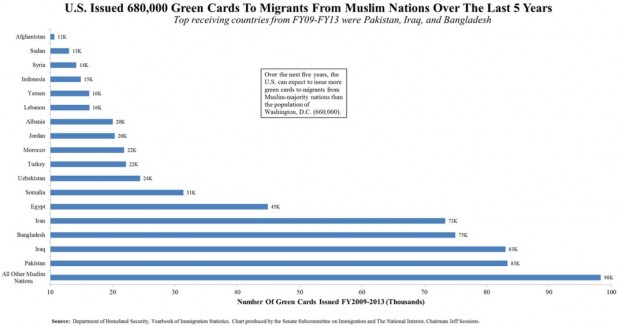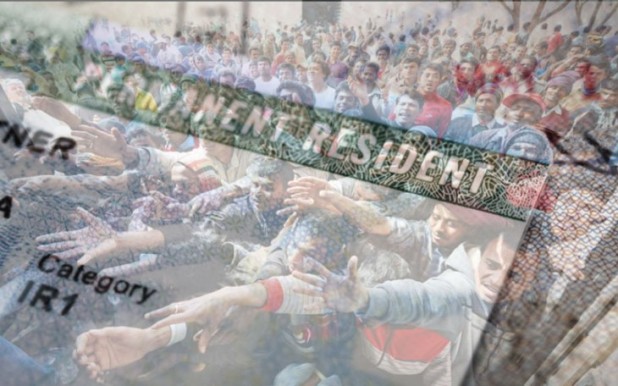The New Observer
November 27, 2015
More Muslims have been given American “green cards”—or permanent residence—in the last five years than the entire population of Washington DC, and projections are that an equal number will be given that status over the next five years, Jeff Sessions, US Senator for Alabama, has announced.
 In a press release on his official government website, Senator Sessions, who is also Chairman of the Senate Subcommittee on Immigration, Border Security, and Refugees, said that the Department of Homeland Security (DHS) issued 680,000 green cards to migrants from Muslim nations over the last five years.
In a press release on his official government website, Senator Sessions, who is also Chairman of the Senate Subcommittee on Immigration, Border Security, and Refugees, said that the Department of Homeland Security (DHS) issued 680,000 green cards to migrants from Muslim nations over the last five years.
Senator Sessions was quick to point out that this figure is “not an estimate of total migration, as it does not include temporary migrants who return home, nor is it an estimate of population change, as it does not include births or deaths, among other considerations.”
Furthermore, he advised, the “numbers could be higher still: Census Bureau data shows migration from the Middle East to be one of the fastest-growing categories.”
Pakistan—which is also the source of the largest number of Muslim terrorists in Europe—accounted for 83,000 Green Cards issued, followed by Iraq (83,000), Bangladesh (75,000), Iran (73,000), Egypt (45,000), Somalia (31,000), Uzbekistan (24,000), Turkey (22,000), Morocco (22,000), Jordan (20,000), Albania (20,000), Lebanon (16,000), Yemen (16,000), Indonesia (15,000), Syria (14,000), Sudan (13,000), Afghanistan (11,000), Sierra Leone (10,000), Guinea (8,000), Senegal (7,000), Saudi Arabia (7,000), Algeria (7,000), Kazakhstan (7,000), Kuwait (5,000), Gambia (5,000), United Arab Emirates (4,000), Azerbaijan (4,000), Mali (3,000), Burkina Faso (3,000), Kyrgyzstan (3,000), Kosovo (3,000), Mauritania (2,000), Tunisia (2,000), Tajikistan (2,000), Libya (2,000), Turkmenistan (1,000), Qatar (1,000), and Chad (1,000).

A green card entitles recipients to access federal benefits, lifetime residency, work authorization, and a direct route to becoming a US citizen.
Senator Sessions added that, “if left in place, the president’s refugee plan would substantially boost the annual number of migrants from this region admitted to the US who, in turn, would be able to petition for their relatives to migrate to the US in the future. Refugee and asylee admissions from Iraq, Somalia, and Iran alone contributed 124,000 individuals from FY09–FY13.”
Refugees have instant access to federal welfare and entitlements, along with local benefits and education services; these costs are not offset.
He also put these figures into what he called a “numerical context,” namely that according to the US Census Bureau, the foreign-born population in the United States is at a record 41.3 million.
This means, he continued, that “one-quarter of the US population is now either foreign-born or has foreign-born parents” and that projections are that “the percentage of the population born outside the country will soon pass the highest percentage ever recorded and continue rising to new all-time records never before witnessed—unless Congress passes a law to reduce green card allotments.”
In 1970, fewer than 1 in 21 US residents were foreign-born. Today, it is nearly 1 in 7 and rising. The social and economic effects of this are far-reaching, Senator Sessions explained:
“This enormous growth in the foreign labor supply—driven by green cards—has held down pay and salaries. Wages today are lower than they were in 1973,” he said, adding that polling data from the authoritative Pew Research Center shows that 83 percent of the American public believes the level of immigration should either be frozen or reduced.
“Pew projects that this next immigration wave will add another 103 million to the US population (new immigrant arrivals and their future children) by 2065—or the population equivalent of 25 cities of Los Angeles.”
 Daily Stormer The Most Censored Publication in History
Daily Stormer The Most Censored Publication in History



